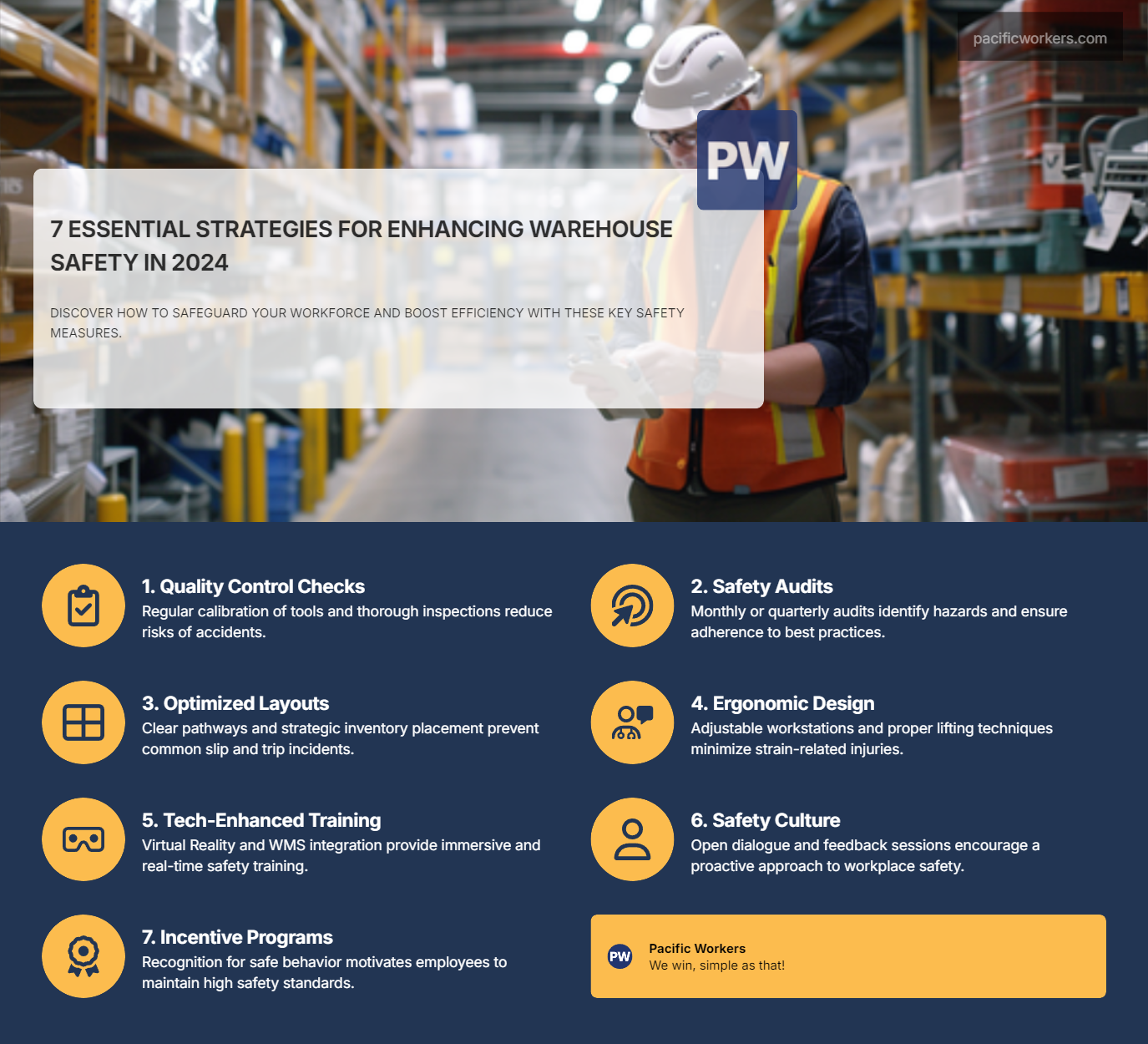Workplace injuries in workplaces can have significant repercussions for the affected employees and the overall efficiency and morale of the workforce. Obviously, it requires strategies for to reduce workplace injuries in warehouses. For instance, with slips, trips, falls, and forklift accidents being some of the most common incidents, it's clear that proactive safety measures are essential. But what specific strategies may the stockroom managers implement to create a safer environment in 2024?
This article explores five key strategies that could make a substantial difference. From optimizing workplace layouts to leveraging cutting-edge technology like Virtual Reality for safety training, these approaches are designed to address the unique challenges of retail store operations.
How can regular safety audits and fostering a culture contribute to reducing injuries? Read on to discover practical tips and the latest secure protocols that ought to help you enhance worker well-being and operational efficiency.
Enhancing Quality Control Measures
1. Tightening Up Quality Control Basics
Quality control is vital for warehouse safety. Also, it’s one of the best strategies for to reduce workplace injuries in warehousing facilities. Accurate measurements and thorough inspections are essential in preventing accidents. When quality control measures are lax, the risk of errors increases, leading to potential hazards such as falling objects or equipment malfunctions. Ensuring that all products meet specific standards before they are moved or stored can radically reduce these risks.
Regularly calibrating measurement tools and training staff on proper inspection techniques are fundamental steps. That not only ensures that products are handled correctly, but also that any potential issues are identified and addressed promptly.
Implementing Regular Safety Audits
Safety audits are a proactive approach to identifying and mitigating risks. Besides, are pivotal part of the strategies for to reduce workplace injuries in stockrooms. Conducting these audits regularly, such as monthly or quarterly, allows for continuous monitoring of best practices and the identification of new hazards. The scope of these audits should cover all aspects of warehouse operations, from equipment maintenance to employee practices.
Involving employees in safety checks can enhance the effectiveness of these audits. Workers often have first-hand knowledge of potential hazards and might provide valuable insights. Such a collaborative approach not only improves safeguarding but also fosters a culture of accountability and engagement.
2. Optimizing Warehouse Layout for Safety
Strategic Placement of Equipment and Inventory

A well-organized storage unit layout is crucial for minimizing accidents. Cluttered pathways and poorly stored inventory can lead to slips, trips, and falls, which are among the most common types of storage injuries. Ensuring clear pathways and strategically placing equipment and inventory should prevent these incidents.
Safe storage practices are also essential. Heavy items should be stored on lower shelves to prevent falling objects, and frequently used items should be easily accessible to reduce the need for reaching and bending. These practices not only enhance safety but also improve operational efficiency.
3. Ergonomic Considerations, Relevant as Strategies for to Reduce Workplace Injuries in Warehouses
Designing workstations with ergonomics in mind can considerably reduce the risk of repetitive strain injuries (RSIs), which account for 56 percent of illnesses reported to OSHA. Ergonomic tools and equipment, such as adjustable workstations and anti-fatigue mats, help minimize strain on workers' bodies.
Regular training on proper lifting techniques and the use of ergonomic tools tend to further reduce the risk of injury. By prioritizing ergonomics, storehouses must create a safer and more comfortable working environment for their employees.
4. Leveraging Technology for Safety
Warehouse Management Systems (WMS)
Warehouse Management Systems (WMS) can play a pivotal role in enhancing safety protocols. These systems provide real-time tracking and monitoring of inventory, which helps in maintaining an organized and clutter-free store. WMS might also track security compliance, ensuring that all protective measures are consistently followed.
By automating routine tasks and providing real-time data, WMS should help identify potential hazards before they become serious issues. This proactive approach tends to strongly reduce the risk of accidents and improve overall well-being.
Safety Training and Virtual Reality (VR)
Virtual Reality (VR) training is an innovative approach to safety training. VR allows employees to experience high-risk scenarios in a controlled environment, which can enhance their understanding and preparedness. That type of training is particularly effective for forklift operators, who are involved in a considerable number of warehouse accidents.
Continuous learning and refresher courses are also essential. Regular training sessions ensure that employees stay updated on the latest risk mitigation protocols and practices. In addition, ongoing education helps maintain a high level of security awareness and preparedness.
5. Fostering a Safety-First Culture
Employee Engagement and Communication
Encouraging open dialogue about safety concerns is crucial for fostering a security-oriented culture. Regular secure meetings and feedback sessions provide a platform for employees to voice their concerns and suggest improvements. This collaborative approach not only enhances protection, but also empowers employees to take an active role in maintaining a safe working environment.
Effective communication is key. Clear and consistent messaging about safety protocols and expectations helps ensure that all employees understand their roles and responsibilities. A bit of clarity can prevent misunderstandings and reduce the risk of accidents.
Recognition and Incentive Programs,
Recognition and incentive programs can motivate employees to prioritize safety. Rewarding safe practices and behaviors reinforces the importance of secure operations and encourages employees to adhere to protocols. These programs usually include monetary rewards, public recognition, or additional time off.
Building a culture of accountability and responsibility is essential. When employees understand that their actions have a direct impact on their safety and of their colleagues, they are more likely to take security seriously. An organizational culture of accountability will reduce the risk of workplace injuries.
By implementing these strategies, storehouse managers can create a safer and more efficient working environment. Each of these approaches addresses specific aspects of plant protection, from quality control to employee engagement, ensuring a comprehensive and effective prevention program.
Conclusion: Work in Strategies for to Reduce Workplace Injuries in Warehouses
Proactive safety measures are essential in reducing workplace injuries in factories. By tightening up quality control, implementing regular safeguarding audits, and optimizing workplace layouts, managers can address common hazards like slips, trips, and falls. Leveraging technology, such as Warehouse Management Systems and Virtual Reality training, further enhances protocols and preparedness. Fostering a security-oriented culture through employee engagement and recognition programs ensures that health and wellness remains a top priority.
These strategies not only improve secure operations but also boost operational efficiency and workforce morale. As we move into 2024, it's clear that a comprehensive approach to storehouse safeguarding is crucial. By prioritizing these measures, depot managers must create a safer, more productive environment. Remember, a safe workplace isn't just a regulatory requirement—it's a commitment to the well-being of every employee. Let's make 2024 the year we transform safety standards in our warehouses.
About the Author

Michael J. Ullrich is a Managing Attorney with Pacific Workers’ Compensation. Born and raised in Philadelphia, he has been a San Francisco resident since 1999. He attended Pennsylvania State University for his undergraduate studies and received a B.A. in History. Mr. Ullrich earned his J.D. at Golden Gate Law School and earned numerous Witkin and CALI awards for academic excellence. During his legal studies, he worked as a law clerk at an environmental firm and volunteered at the Women’s Employment Rights Clinic. Prior to pursuing a career in the law, Michael worked in trading stock and options.
Since he began practicing law, Mr. Ullrich has worked in workers’ compensation and employee relations. Prior to joining PWC, he held positions with Richard, Thorson, Graves & Royer, and with the City and County of San Francisco. Michael joined Pacific Workers’ Compensation because he wanted to protect injured workers from the cost-cutting measures of insurance companies.
When not fighting for his clients, Mr. Ullrich enjoys playing softball, mountain biking, and giving long-winded opinions about sports.
Education
Golden Gate University School of Law, J.D., 2011
Pennsylvania State University, B.A., History, 1996


